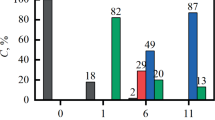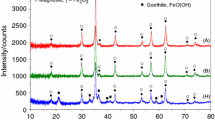Abstract
The reduction of magnetite of technical grade and magnetite doped with 3 mass pct Al2O3 was studied in situ using high-temperature XRD (HT-XRD) analysis. Magnetite was reduced by CO-CO2 gas (80 vol pct CO) at 1023 K (750 °C). Reduction of magnetite doped with alumina occurred from the Fe3O4-FeAl2O4 solid solution which has a miscibility gap with critical temperature of 1133 K (860 °C). The degree of reduction of magnetite was derived using Rietveld refinement of the HT-XRD spectra; the compositions of the Fe3O4-FeAl2O4 solid solution and the concentrations of carbon in γ-iron were determined from the lattice constants of the solutions. The reduction of magnetite progressed topochemically with the formation of a dense iron shell. The reduction of alumina-containing magnetite started along certain lattice planes with the formation of a network-like structure. Reduction of alumina-containing magnetite was faster than that of un-doped magnetite; this difference was attributed to the formation of the network-like structure. Hercynite content in the Fe3O4-FeAl2O4 solid solution in the process of reduction of magnetite doped with 3 mass pct Al2O3 increased from 5.11 to 20 mass pct, which is close to the miscibility gap at 1023 K (750 °C). The concentration of carbon in γ-Fe (0.76 mass pct) formed in the reduced sample of magnetite doped with 3 mass pct Al2O3 was close to the equilibrium value with 80 vol pct CO to 20 vol pct CO2 gas used in the HT-XRD experiments.















Similar content being viewed by others
References
H. K. Kohl and H. J. Engell, Arch. Eisenhüttenwes., 1963, vol. 34, pp. 411-18.
W. Plusshkell and B. V. S. Sarma, Eisenhüttenwes., 1973, vol.44, pp. 161-66.
S. P. Matthew and P. C. Hayes, Metall. Trans. B, 1990, vol. 21B, pp. 141-51.
S. P. Matthew and P. C. Hayes, Metall. Trans. B, 1990, vol. 21B, pp.153-72.
S. P. Matthew, T. R. Cho and P. C. Hayes, Metall. Trans. B, 1990, vol. 21B, pp. 733-41.
M. Bahgat and M. H. Khedr, Mat. Sci. Eng. B, 2007, vol.138, pp. 251-58.
H. P. Pimenta and V. Seshadri: Ironmaking and Steelmaking, 2002, vol. 29, pp. 175-79.
T. Sharma, R. G. Gupta and B. Prakash: ISIJ Int., 1993, vol. 33, pp. 446-53.
Y. Suzuki, M. Yamamoto, T. Kotanigawa and K. Nishida: Metall. Trans. B, 1981, 12B, pp. 691-98.
Y. Iguchi and M. Inouye: Trans. ISIJ, 1982, vol. 22, pp. 678-88.
T. Paananen, K. Heinänen and J. Härkki: ISIJ Int., 2003, vol. 43, pp. 597–605.
Y. Kapelyushin, X. Xing, J. Zhang, Y. Sasaki and O. Ostrovski, Metall. Trans. B, 2015, vol. 46, pp. 1175-1185.
A.C. Turnock and H.P. Eugster: J. Petrol, 1962, vol. 3, pp. 533-565.
L. Cheng, A. Böttger, Th. H. de Keijser and E. J. Mittenmeijer: Scr. Met. Mater., 1990, vol. 24, pp. 50-14.
M. Onink, C. M. Brakman, F. D. Tichelaar, E. J. Mittenmeijer and S. van der Zwaag: Scr. Met & Mater., 1993, vol. 29, pp. 1011-16.
I. Seki and K. Nagata: ISIJ Int., 2005, vol. 45, pp. 1789-94.
X. Chen and E. Vourine: ISIJ. Int., 2009, vol. 49, pp. 1220-24.
S. S. Babu, E. D. Specht, S. A. David, E. Karapetrova, P. Zschack, M. J. Peet and H. K. D. H. Bhadeshia: Metall. Mater. Trans. A, 2005, vol. 36A, pp. 3281-89.
H. J. Stone, M. Peet, H. K. D. H. Bhadeshia, P. J. Withers, S. S. Babu and E. D. Specht: Proc. R. Soc. A, 2008, vol. 464, pp. 1009-27.
M. Kimura and R. Murao: ISIJ Int., 2013, vol. 53, pp. 2047-55.
N. V. Y. Scarlett, M. I. Pownceby, I. C. Madsen and A. N. Christensen: Metall. Mater. Trans. B, 2004, vol. 35B, pp. 929-36.
N. A. S. Webster, M. I. Pownceby, I. C. Madsen and J. A. Kimpton: Metall. Mater. Trans. B, 2012, vol. 43B, pp.1344-57.
N. A. S. Webster, M. I. Pownceby, I. C. Madsen and J. A. Kimpton: ISIJ. Int., 2013, vol.53, pp. 774-81.
H. Ree and M. Tate: Tetsu-to-Hagané (in Japanese), 1974, vol. 60, pp. 480-85.
W. K. Jozwiak, E. Kaczmarek, T. P. Maniecki, W. Ignaczak and W. Maniukiewicz: Applied Catalysis A, 2007, 326, pp. 17-27.
H. M. Rietveld: J. Appl. Cryst., 1969, vol. 2, 65-71.
H. Jung and W. J. Thomsan: J. Catal., 1991, 128, 218-30.
A. Hoffmann and W. A. Fisher: Z. Phys. Chem. N. F., 1956, vol. 7, 80-90.
L. M. Atlas and W. K. Sumida: J. Amer. Ceram. Soc., 1958, vol. 41, 150-160.
R. P. Smith: J. Amer. Chem. Soc., 1946, vol. 69, 1163-75.
R. J. Hill: Am. Mineral., 1984, vol. 69, 937-942.
Acknowledgements
This project was financially supported by POSCO (South Korea) and Australian Research Council (ARC Linkage Project LP1200200634).
Author information
Authors and Affiliations
Corresponding author
Additional information
Manuscript submitted May 4, 2015.
Appendix
Appendix
Calculation of the degree of reduction of magnetite from results of HT-XRD analysis
Alumina and impurities in samples Mag0 and Mag3 were ignored. Iron in the reduced samples existed in unreduced magnetite, wüstite, and metallic iron. Mass fractions of these phases in the sample at different reduction stages were determined by the Rietveld refinement of the XRD spectra: a is mass pct of magnetite (magnetite-based solid solution in Mag3), b is mass pct of wüstite, and c is mass pct of Fe (α-Fe + γ-Fe). Calculation of the degree of magnetite reduction was based on Eq. [2].
-
(1)
The initial mass of magnetite was calculated from the mass balance for iron as follows:
$$ M_{\text{mag}} = [a + (W_{\text{mag}} /3W_{\text{wus}} )b + (W_{\text{mag}} /3W_{\text{Fe}} )c] $$where W mag, W wus, and W Fe are mole masses of magnetite (=232), wüstite (=72), and iron (=56).
-
(2)
The initial oxygen content (g) in magnetite before the reduction is
$$ M_{\text{O}} = \, (W_{\text{mO}} /W_{\text{mag}} ) \, M_{\text{mag}} \left( g \right) $$The removed oxygen from magnetite is
$$ [(W_{\text{O}} /3W_{\text{wus}} )b + (W_{\text{mO}} /W_{\text{Fe}} )c] $$where W O and W mO are the mole mass of oxygen (=16) and mass of oxygen in one mole magnetite (=64).
-
(3)
Thus, the degree of reduction RD is calculated as follows:
$$ {\text{RD}} = [(W_{\text{O}} /3W_{\text{wus}} )b + (W_{\text{mO}} /W_{\text{Fe}} )c]/M_{\text{O}} $$
Rights and permissions
About this article
Cite this article
Kapelyushin, Y., Sasaki, Y., Zhang, J. et al. In-Situ Study of Gaseous Reduction of Magnetite Doped with Alumina Using High-Temperature XRD Analysis. Metall Mater Trans B 46, 2564–2572 (2015). https://doi.org/10.1007/s11663-015-0437-4
Published:
Issue Date:
DOI: https://doi.org/10.1007/s11663-015-0437-4




